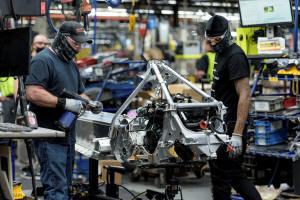U.S. manufacturing output softens; leading indicator extends decline
 Send a link to a friend
Send a link to a friend
 [June 18, 2022]
By Lucia Mutikani [June 18, 2022]
By Lucia Mutikani
WASHINGTON (Reuters) - Production at U.S.
factories unexpectedly fell in May, the latest sign of cooling economic
activity as the Federal Reserve aggressively tightens monetary policy to
tame inflation.
Slowing growth was indicated in other data showing a gauge of future
economic activity declining in May for a third straight month. Other
data this week showed a drop in retail sales last month as well as steep
declines in homebuilding and permits. Weakness in manufacturing output
also reflects a shift in spending from goods to services.
"It adds to the evidence that the economy is slowing," said Andrew
Hunter, a senior U.S. economist at Capital Economics. "But there is
still little in activity data to suggest a recession is on the horizon,
or to dissuade the Fed from pressing ahead with more aggressive policy
tightening."
Manufacturing output dipped 0.1% last month, the first decline since
January, after increasing 0.8% in April, the Fed said. Economists polled
by Reuters had forecast factory production gaining 0.3%. Output rose
4.8% compared to May 2021.

Strong demand for good has supported manufacturing, which accounts for
12% of the U.S. economy. But spending is gradually reverting back to
services, while Russia's dragging war against Ukraine and China's
zero-tolerance COVID-19 policy have further entangled supply chains.
A strong dollar as a result of rising interest rates could make U.S.
exports more expensive. The U.S. central bank has hiked its policy
interest rate by 150 basis points since March.
A separate report from the Conference Board on Friday showed its Leading
Economic Index fell 0.4% in May, matching the decline in April. Though
the index remains near historic highs, it is down 0.4% from last
November through May. Last month's decline was driven by plunging stock
prices, the slowdown in homebuilding and gloomier consumer expectations.
"The index remains at a historic high, but recent declines point to a
weaker near-term outlook," said Justin Begley, an economist at Moody's
Analytics in West Chester, Pennsylvania. "As such, growth will be rather
tepid."
Stocks on Wall Street were mostly lower. The dollar rallied against a
basket of currencies. U.S. Treasury prices fell.
MOMENTUM SLOWING
Though the drop in factory production was tiny and economists expected a
rebound, manufacturing is slowing.
[to top of second column] |

People work on a Polaris snowmobile assembly line at their
manufacturing and assembly plant in Roseau, Minnesota, U.S. June 7,
2021. Picture taken June 7, 2021. REUTERS/Dan Koeck

A survey from the New York Fed this week showed activity at factories in New
York state remained soft in June, with unfilled orders falling for the first
time in over a year. Weaker conditions were also reported in the mid-Atlantic
region, with the Philadelphia Fed's measure of manufacturing activity posting a
negative reading this month for the first time since May 2020.
"This could be a sign that higher interest rates, tighter financial conditions,
and expectations of weaker demand are starting to weigh on business investment,"
said Veronica Clark, an economist at Citigroup in New York.
May's surprise decline in factory production followed three months of growth
averaging nearly 1%. Nondurable manufacturing production edged up 0.1%,
supported by increases in petroleum and coal products, which offset declines in
food, beverage and tobacco products as well as paper and printing.
But the output of long-lasting goods fell 0.2%, pulled down by declines in wood
products and machinery. Production at auto plants rose 0.7% last month after
advancing 3.3% in April.
Mining production increased 1.3% after rising 1.1% in the prior month. It
continues to be boosted oil and gas extraction as the Russia-Ukraine war drives
up crude prices. Oil and gas well drilling surged 6.2%.
Utilities output climbed 1.0% after accelerating 5.5% in April. The solid gains
in mining and utilities offset the dip in manufacturing, lifting overall
industrial production 0.2%. Industrial output jumped 1.4% in April.
Capacity utilization for the manufacturing sector, a measure of how fully firms
are using their resources, edged down 0.1 percentage point to 79.1% in May. It
is 1.0 percentage points above its long-run average. Overall capacity use for
the industrial sector rose to 79.0% last month from 78.9% in April. It is 0.5
percentage points below its 1972-2021 average.

Officials at the Fed tend to look at capacity use measures for signals of how
much "slack" remains in the economy - how far growth has room to run before it
becomes inflationary.
(Reporting by Lucia Mutikani; Editing by Chizu Nomiyama and David Gregorio)
[© 2022 Thomson Reuters. All rights
reserved.]This material may not be published,
broadcast, rewritten or redistributed.
Thompson Reuters is solely responsible for this content. |